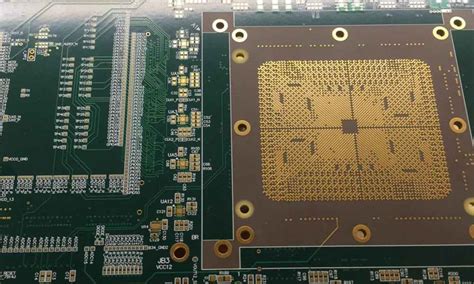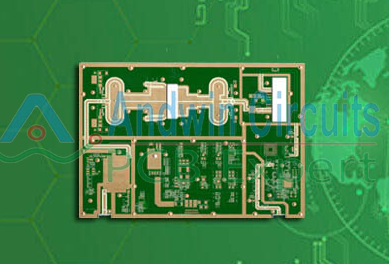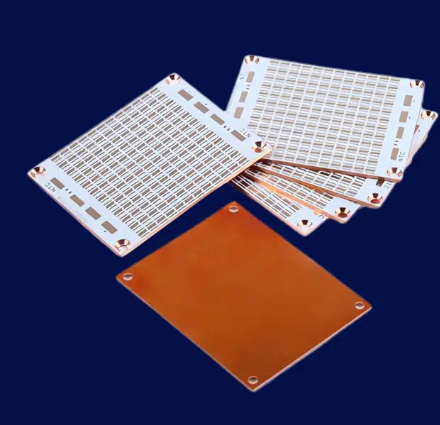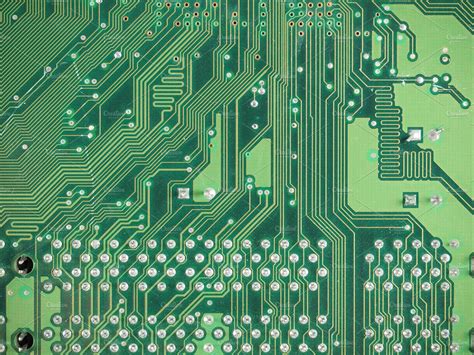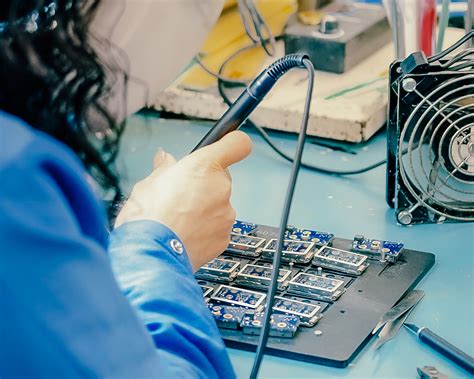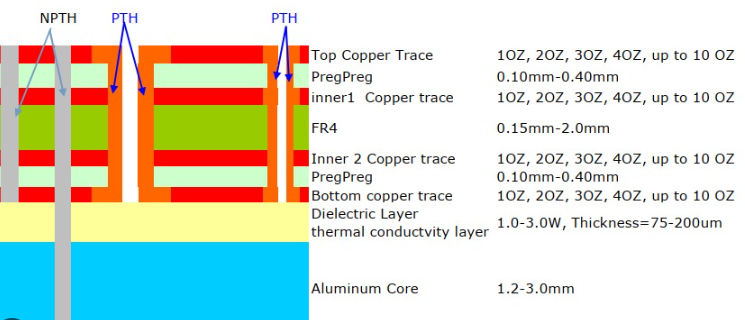Metal core pcb material
Advantages Of Metal Core PCB Material In High-Power Applications
Metal core printed circuit boards (PCBs) have emerged as a pivotal innovation in the realm of high-power applications, offering a multitude of advantages that make them indispensable in various industries.
One of the primary benefits of metal core PCB material is its superior thermal management capabilities.
Traditional PCBs, typically made from materials like FR4, often struggle to dissipate heat efficiently, leading to potential overheating and failure of electronic components. In contrast, metal core PCBs, which incorporate a metal layer—usually aluminum or copper—excel in conducting heat away from critical components. This enhanced thermal conductivity ensures that the PCB operates within safe temperature ranges, thereby extending the lifespan of the electronic devices and improving their reliability.
Moreover, the mechanical stability provided by metal core PCBs is another significant advantage
High-power applications often subject PCBs to rigorous operating conditions, including mechanical stress and vibrations. The robust nature of metal core materials offers greater durability and resistance to such stresses compared to their non-metal counterparts. This mechanical resilience is particularly beneficial in automotive, aerospace, and industrial applications, where reliability and longevity are paramount.
In addition to thermal and mechanical benefits, metal core PCBs also contribute to improved electrical performance.
The metal layer within the PCB can act as a ground plane, reducing electromagnetic interference (EMI) and enhancing signal integrity. This is crucial in high-power applications where maintaining signal clarity and minimizing noise is essential for optimal performance. The ability to manage EMI effectively makes metal core PCBs a preferred choice in telecommunications, power electronics, and other sectors where signal integrity is critical.
Furthermore, the design flexibility offered by metal core PCBs cannot be overlooked.
These PCBs can be manufactured in various configurations, including single-layer, double-layer, and multi-layer designs, to meet the specific requirements of different applications. This versatility allows engineers to tailor the PCB design to optimize performance, thermal management, and space utilization. The adaptability of metal core PCBs makes them suitable for a wide range of high-power applications, from LED lighting systems to power supplies and motor controllers.
Another noteworthy advantage is the potential for cost savings in the long run.
While the initial cost of metal core PCBs may be higher than traditional PCBs, their enhanced durability and thermal management capabilities can lead to reduced maintenance and replacement costs. The extended lifespan and improved reliability of devices using metal core PCBs translate to lower total cost of ownership, making them a cost-effective solution for high-power applications.
In conclusion, the advantages of metal core PCB material in high-power applications are manifold. The superior thermal management, mechanical stability, improved electrical performance, design flexibility, and potential cost savings collectively make metal core PCBs an invaluable asset in various industries. As technology continues to advance and the demand for high-power applications grows, the adoption of metal core PCBs is likely to increase, further solidifying their role as a cornerstone in the development of reliable and efficient electronic devices.

Thermal Management Solutions Using Metal Core PCB Material
Metal core printed circuit boards (PCBs) have emerged as a pivotal solution in the realm of thermal management, addressing the escalating demands of modern electronic devices. As electronic components become increasingly powerful and compact, the need for efficient heat dissipation has never been more critical. Metal core PCBs, often constructed with a base metal material such as aluminum or copper, offer a robust solution to this challenge by providing superior thermal conductivity compared to traditional fiberglass-based PCBs.
The primary advantage of metal core PCBs lies in their ability to effectively manage and dissipate heat.
This is achieved through the metal core, which acts as a heat sink, drawing heat away from the components and distributing it across the board. Consequently, this reduces the risk of overheating, which can lead to component failure and reduced lifespan of the electronic device. By maintaining optimal operating temperatures, metal core PCBs enhance the reliability and performance of electronic systems, making them indispensable in high-power applications.
In addition to their thermal management capabilities, metal core PCBs also offer mechanical benefits.
The metal substrate provides a sturdy foundation, enhancing the overall durability and structural integrity of the PCB. This is particularly advantageous in applications where the PCB is subjected to mechanical stress or harsh environmental conditions. The robustness of metal core PCBs ensures that they can withstand such challenges without compromising their performance.
Moreover, the use of metal core PCBs is not limited to high-power applications alone.
They are also increasingly being adopted in LED lighting systems, where efficient heat dissipation is crucial for maintaining the longevity and brightness of the LEDs. The metal core helps to manage the heat generated by the LEDs, preventing thermal degradation and ensuring consistent performance over time. This makes metal core PCBs an ideal choice for a wide range of lighting applications, from residential to industrial settings.
Furthermore, the integration of metal core PCBs into electronic designs can lead to cost savings in the long run.
By effectively managing heat, these PCBs reduce the need for additional cooling mechanisms such as fans or heat sinks, which can add to the overall cost and complexity of the system. Additionally, the enhanced reliability and longevity of devices using metal core PCBs can result in lower maintenance and replacement costs, further contributing to cost efficiency.
Despite their numerous advantages, it is important to consider certain factors when designing with metal core PCBs.
The thermal expansion properties of the metal core must be compatible with the other materials used in the PCB to prevent mechanical stress and potential damage. Additionally, the manufacturing process for metal core PCBs can be more complex and may require specialized equipment and techniques. However, with careful design and manufacturing practices, these challenges can be effectively managed.
In conclusion, metal core PCBs represent a significant advancement in thermal management solutions for modern electronic devices. Their superior heat dissipation capabilities, combined with enhanced mechanical strength and potential cost savings, make them an attractive option for a wide range of applications. As the demand for high-performance, reliable electronic systems continues to grow, the adoption of metal core PCBs is likely to increase, solidifying their role as a cornerstone of thermal management in the electronics industry.
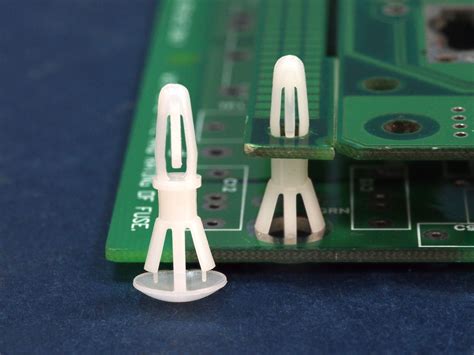
Comparing Metal Core PCB Material To Traditional PCB Substrates
Metal core printed circuit boards (PCBs) have emerged as a significant advancement in the field of electronics, offering distinct advantages over traditional PCB substrates. To understand the benefits and limitations of metal core PCBs, it is essential to compare them with conventional materials such as FR4, a widely used fiberglass-reinforced epoxy laminate.
One of the primary differences between metal core PCBs and traditional substrates lies in their thermal management capabilities.
Metal core PCBs, typically composed of aluminum or copper cores, exhibit superior thermal conductivity. This characteristic allows for efficient heat dissipation, which is crucial in high-power applications where excessive heat can lead to component failure or reduced performance. In contrast, FR4 substrates have relatively poor thermal conductivity, necessitating additional cooling mechanisms such as heat sinks or fans to manage heat effectively.
Furthermore, the mechanical properties of metal core PCBs offer distinct advantages.
The metal core provides enhanced structural integrity and rigidity, making these PCBs less prone to warping or bending under mechanical stress. This robustness is particularly beneficial in applications subjected to harsh environmental conditions or mechanical vibrations. On the other hand, traditional FR4 substrates, while adequate for many applications, may not offer the same level of durability and can be more susceptible to mechanical damage.
In addition to thermal and mechanical benefits, metal core PCBs also exhibit improved electrical performance.
The metal core acts as a ground plane, reducing electromagnetic interference (EMI) and enhancing signal integrity. This feature is especially valuable in high-frequency applications where signal integrity is paramount. Conversely, traditional FR4 substrates may require additional design considerations, such as the inclusion of ground planes or shielding, to achieve similar levels of EMI reduction.
However, it is important to consider the potential drawbacks of metal core PCBs.
One notable disadvantage is the increased cost associated with their production. The use of metal cores, particularly copper, can significantly raise material costs compared to FR4 substrates. Additionally, the manufacturing process for metal core PCBs is more complex, requiring specialized equipment and techniques. These factors can contribute to higher overall production costs, which may be a limiting factor for cost-sensitive applications.
Moreover, the weight of metal core PCBs can be a consideration in certain applications.
The metal core adds to the overall weight of the PCB, which may be a disadvantage in weight-sensitive designs, such as aerospace or portable electronic devices. In contrast, traditional FR4 substrates are lighter, making them more suitable for applications where weight is a critical factor.
Despite these potential drawbacks, the advantages of metal core PCBs make them an attractive choice for specific applications.
Industries such as automotive, LED lighting, and power electronics have increasingly adopted metal core PCBs due to their superior thermal management, mechanical robustness, and enhanced electrical performance. As technology continues to advance, the demand for high-performance PCBs is expected to grow, further driving the adoption of metal core substrates.
In conclusion, while traditional PCB substrates like FR4 remain widely used and suitable for many applications, metal core PCBs offer distinct advantages in terms of thermal management, mechanical strength, and electrical performance. However, the increased cost and weight associated with metal core PCBs must be carefully considered in the context of specific application requirements. By understanding the comparative benefits and limitations of these materials, designers and engineers can make informed decisions to optimize the performance and reliability of their electronic systems.
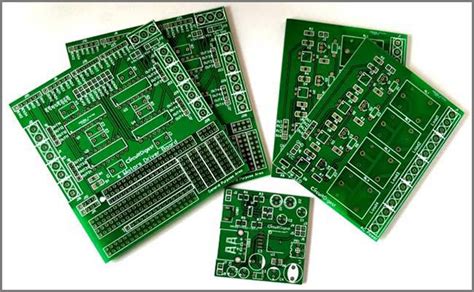
Innovations In Metal Core PCB Material For Enhanced Durability
Metal core printed circuit boards (PCBs) have emerged as a pivotal innovation in the electronics industry, particularly for applications requiring enhanced thermal management and durability. These PCBs incorporate a metal substrate, typically aluminum or copper, which serves as a heat sink to dissipate heat more efficiently than traditional fiberglass-based PCBs. This characteristic is especially crucial in high-power applications such as LED lighting, power supplies, and automotive electronics, where excessive heat can compromise performance and longevity.
One of the primary advantages of metal core PCBs is their superior thermal conductivity.
Traditional PCBs, made from materials like FR4, often struggle to manage heat effectively, leading to potential overheating and failure of electronic components. In contrast, metal core PCBs can conduct heat away from critical components much more efficiently, thereby enhancing the overall reliability and lifespan of the device. This improved thermal management is achieved through the metal core’s ability to spread heat across a larger surface area, reducing hotspots and maintaining a more stable operating temperature.
In addition to thermal management, metal core PCBs offer enhanced mechanical stability.
The metal substrate provides a robust foundation that can withstand mechanical stress and vibration better than conventional PCBs. This attribute is particularly beneficial in automotive and industrial applications, where electronic systems are often exposed to harsh operating conditions. The increased durability of metal core PCBs ensures that they can maintain their structural integrity and functionality over extended periods, even in demanding environments.
Moreover, the advancements in metal core PCB materials have led to the development of multilayer designs, which further enhance their versatility and performance.
Multilayer metal core PCBs can incorporate multiple layers of circuitry, separated by insulating materials, while still benefiting from the thermal and mechanical advantages of the metal substrate. This capability allows for more complex and compact designs, enabling engineers to create sophisticated electronic systems without compromising on durability or thermal management.
The choice of metal substrate also plays a crucial role in the performance of metal core PCBs.
Aluminum is commonly used due to its excellent thermal conductivity, lightweight nature, and cost-effectiveness. However, copper is another popular choice, offering even higher thermal conductivity and electrical performance, albeit at a higher cost. The selection of the appropriate metal substrate depends on the specific requirements of the application, balancing factors such as thermal performance, mechanical strength, weight, and cost.
Furthermore, the integration of advanced manufacturing techniques has significantly improved the quality and consistency of metal core PCBs.
Techniques such as laser drilling, precision etching, and automated assembly have enabled the production of highly reliable and precise metal core PCBs. These advancements ensure that the final product meets stringent industry standards and performs optimally in real-world applications.
In conclusion, the innovations in metal core PCB materials have revolutionized the electronics industry by providing enhanced thermal management, mechanical stability, and design flexibility. These advancements have made metal core PCBs an indispensable component in high-power and high-reliability applications, ensuring that electronic systems can operate efficiently and reliably even in the most demanding conditions. As technology continues to evolve, further improvements in metal core PCB materials and manufacturing processes are expected, paving the way for even more robust and efficient electronic solutions.

